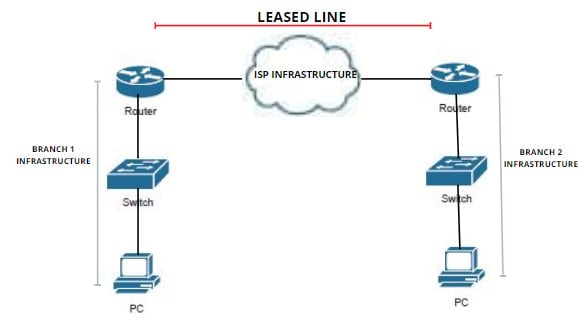Local Area Network (LAN) is where we connect the endpoint devices like servers, desktops, telephones, and access points. To connect the device within the LAN to a different device within the different LAN, we are using a Wide Area Network (WAN). In WAN, two or more local area networks can relate to different layer 3 devices like routers or firewalls. The common type of WAN is leased line connection.
Understanding Leased Lines
A leased line, sometimes called a dedicated line, is a dedicated point-to-point link and fixed-bandwidth data connection. A leased line is not a dedicated cable. It is a reserved dedicated leased line circuit (either a copper or a fiber optic cable) between two points.
The leased line transfers data in both directions using a full-duplex transmission. It uses two pairs of wires (full-duplex cable), that each wire is used in a unidirectional transmission of data network. A leased line is not a long physical cable extended to two or more locations as others perceived. It uses a specialized switching device that acts as a signal booster to make the connection a point-to-point link and reach a remote destination.
Organizations are not building their infrastructure to create a dedicated connection to their other branches as it is expensive and difficult to implement. They use the infrastructure of an Internet Service Provider on a fixed monthly fee, which is why it is called a leased line.
The below diagram shows how the leased line connects two branches:
ISP as a Leased Line
A leased line can be of any medium as long as it connects two branches together regardless if it has network circuitry in between. It can be an MPLS, Fiber Optic, DSL, or Satellite. The local Internet Service Provider is the best way to acquire a leased line as they have a huge geographical network infrastructure. It can either be a monthly or yearly subscription, depending on the terms with the ISP.
From the Optical Network Terminal (ONT) located on the customer’s branch, the traffic will go to the Optical Line Termination (OLT) located in the ISP premise, where it multiplexed and processed all the optical signals coming from the customers.
From OLT, it will then go to the edge routers where it uses VRF and adds labels if it is using MPLS. From edge routers, it will then go to the core router using BGP as the overlay protocol and IGP like OSPF as the underlay protocol. From core routers, it will transmit the data to the other edge router, go to OLT, and finally to the ONT, which is located to the other branch of the customer. The transmission equipment used in between the core routers, edge routers, OLT, and ONT is either Synchronous Digital Hierarchy (SDH) or Dense Wavelength Division Multiplexing (DWDM).
Lease Line Advantages and Disadvantages
Most leased lines have a Service Level of Agreement (SLA) to the ISP, which guarantees a reliable and stable internet connection. Because the leased line is a dedicated communication channel, your network will have reliable internet access, continuous data flow, higher bandwidth can be achieved and controlled. You can implement a leased line when you want a completely secured and superior quality of service for your network.
On the other hand, leased lines can be expensive because they need a dedicated cable and switching circuitry. Not only that, the leased line is not scalable as it is a permanent physical connection.
Download our Free CCNA Study Guide PDF for complete notes on all the CCNA 200-301 exam topics in one book.
We recommend the Cisco CCNA Gold Bootcamp as your main CCNA training course. It’s the highest rated Cisco course online with an average rating of 4.8 from over 30,000 public reviews and is the gold standard in CCNA training:

